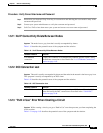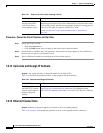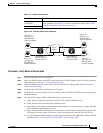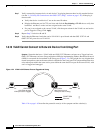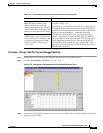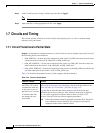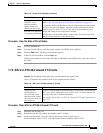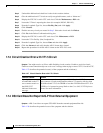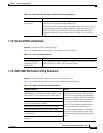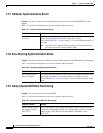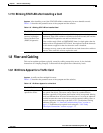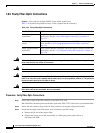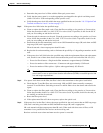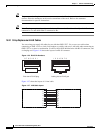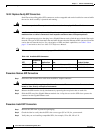
1-69
Cisco ONS 15327 Troubleshooting Guide, R3.4
April 2003
Chapter 1 General Troubleshooting
Circuits and Timing
1.7.5 OC-3 and DCC Limitations
Symptom Limitations to OC-3 and DCC usage.
Table 1-29 describes the potential cause of the symptom and the solution.
1.7.6 ONS 15327 Switches Timing Reference
Symptom Timing references switch when one or more problems occur.
Table 1-30 describes the potential cause(s) of the symptom and the solution(s).
Table 1-28 DS3 Card Does Not Report AIS-P From External Equipment
Possible Problem Solution
The card is functioning
as designed.
This card terminates the port signal at the backplane so STS AIS-P is not
reported from the external equipment/line side.
DS-3 cards have DS-3 header monitoring functionality, which allows you to
view performance monitoring (PM) on the DS-3 path. Nevertheless, you
cannot view AIS-P on the STS path. For more information on the PM
capabilities of the DS-3 cards, refer to the Cisco ONS 15327 Procedure
Guide.
Table 1-29 OC-3 and DCC Limitations
Possible Problem Solution
OC-3 and DCC have
limitations for the
ONS 15327.
For an explanation of OC-3 and DCC limitations, refer to the DCC Tunnels
section of the Cisco ONS 15327 Procedure Guide.
Table 1-30 ONS 15327 Switches Timing Reference
Possible Problem Solution
The optical or building integrated timing supply
(BITS) input is receiving loss of signal (LOS), loss of
frame (LOF), or AIS alarms from its timing source.
The ONS 15327 internal clock operates at a
Stratum 3 level of accuracy. This gives the
ONS 15327 a free-running synchronization
accuracy of ±
4.6 ppm and a holdover stability
of less than 255 slips in the first 24 hours or
3.7 x 10
–7
per day, including temperature.
ONS 15327 free-running synchronization
relies on the Stratum 3 internal clock.
Use a higher quality Stratum 1 or Stratum 2
timing source. This results in fewer timing
slips than a lower quality Stratum 3 timing
source.
The optical or BITS input is not functioning.
Synchronization status message (SSM) is set to Don’t
Use for Synchronization (DUS).
SSM indicates a Stratum 3 or lower clock quality.
The input frequency is off by more than 15 ppm.
The input clock wanders and has more than three slips
in 30 seconds.
A bad timing reference existed for at least two
minutes.



